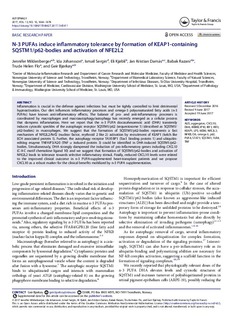| dc.contributor.author | Mildenberger, Jennifer | |
| dc.contributor.author | Johansson, Ida | |
| dc.contributor.author | Sergin, Ismail | |
| dc.contributor.author | Kjøbli, Eli | |
| dc.contributor.author | Damås, Jan Kristian | |
| dc.contributor.author | Razani, Babak | |
| dc.contributor.author | Flo, Trude Helen | |
| dc.contributor.author | Bjørkøy, Geir | |
| dc.date.accessioned | 2018-04-18T07:05:53Z | |
| dc.date.available | 2018-04-18T07:05:53Z | |
| dc.date.created | 2017-10-30T14:58:44Z | |
| dc.date.issued | 2017 | |
| dc.identifier.citation | Autophagy. 2017, 13 (10), 1664-1678. | nb_NO |
| dc.identifier.issn | 1554-8627 | |
| dc.identifier.uri | http://hdl.handle.net/11250/2494562 | |
| dc.description.abstract | Inflammation is crucial in the defense against infections but must be tightly controlled to limit detrimental hyperactivation. Our diet influences inflammatory processes and omega-3 polyunsaturated fatty acids (n-3 PUFAs) have known anti-inflammatory effects. The balance of pro- and anti-inflammatory processes is coordinated by macrophages and macroautophagy/autophagy has recently emerged as a cellular process that dampens inflammation. Here we report that the n-3 PUFA docosahexaenoic acid (DHA) transiently induces cytosolic speckles of the autophagic receptor SQSTM1/p62 (sequestosome 1) (described as SQSTM1/p62-bodies) in macrophages. We suggest that the formation of SQSTM1/p62-bodies represents a fast mechanism of NFE2L2/Nrf2 (nuclear factor, erythroid 2 like 2) activation by recruitment of KEAP1 (kelch like ECH associated protein 1). Further, the autophagy receptor TAX1BP1 (Tax1 binding protein 1) and ubiquitin-editing enzyme TNFAIP3/A20 (TNF α induced protein 3) could be identified in DHA-induced SQSTM1/p62-bodies. Simultaneously, DHA strongly dampened the induction of pro-inflammatory genes including CXCL10 (C-X-C motif chemokine ligand 10) and we suggest that formation of SQSTM1/p62-bodies and activation of NFE2L2 leads to tolerance towards selective inflammatory stimuli. Finally, reduced CXCL10 levels were related to the improved clinical outcome in n-3 PUFA-supplemented heart-transplant patients and we propose CXCL10 as a robust marker for the clinical benefits mobilized by n-3 PUFA supplementation. | nb_NO |
| dc.language.iso | eng | nb_NO |
| dc.publisher | Taylor & Francis | nb_NO |
| dc.rights | Attribution-NonCommercial-NoDerivatives 4.0 Internasjonal | * |
| dc.rights.uri | http://creativecommons.org/licenses/by-nc-nd/4.0/deed.no | * |
| dc.title | N-3 PUFAs induce inflammatory tolerance by formation of KEAP1-containing SQSTM1/p62-bodies and activation of NFE2L2 | nb_NO |
| dc.type | Journal article | nb_NO |
| dc.type | Peer reviewed | nb_NO |
| dc.description.version | publishedVersion | nb_NO |
| dc.source.pagenumber | 1664-1678 | nb_NO |
| dc.source.volume | 13 | nb_NO |
| dc.source.journal | Autophagy | nb_NO |
| dc.source.issue | 10 | nb_NO |
| dc.identifier.doi | 10.1080/15548627.2017.1345411 | |
| dc.identifier.cristin | 1508991 | |
| dc.relation.project | Norges forskningsråd: 223255 | nb_NO |
| dc.description.localcode | © 2017 Jennifer Mildenberger, Ida Johansson, Ismail Sergin, Eli Kjøbli, Jan Kristian Dama s, Babak Razani, Trude Helen Flo, and Geir Bjørkøy. Published with license by Taylor & Francis This is an Open Access article distributed under the terms of the Creative Commons Attribution-NonCommercial-NoDerivatives License (http://creativecommons.org/licenses/by-nc-nd/4.0/), which permits non-commercial re-use, distribution, and reproduction in any medium, provided the original work is properly cited, and is not altered, transformed, or built upon in any way. | nb_NO |
| cristin.unitcode | 194,65,15,0 | |
| cristin.unitcode | 194,66,40,0 | |
| cristin.unitname | Institutt for klinisk og molekylær medisin | |
| cristin.unitname | Institutt for bioingeniørfag | |
| cristin.ispublished | true | |
| cristin.fulltext | original | |
| cristin.qualitycode | 2 | |

